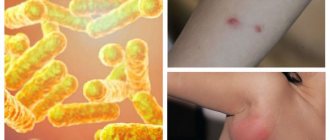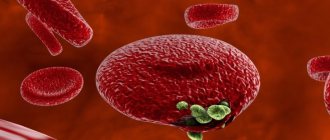Dengue fever - symptoms and treatment
There are two main clinical variants of fever:
- classic dengue fever;
- Dengue fever with hemorrhagic syndrome and shock.
The disease begins acutely, proceeds cyclically and traditionally consists of three periods: febrile, critical and convalescence.
A febrile period occurs suddenly against a background of complete health and is usually accompanied by the following symptoms:
- facial hyperemia - severe redness;
- cutaneous erythema - red spots caused by inflammation and dilation of subcutaneous capillaries;
- generalized acne;
- myalgia - inflammation of muscle fibers;
- joint pain and headache.[6]
Some patients report pain in the throat when swallowing, injection of scleral vessels and in the area of the mucous membrane of the oropharynx. Lack of appetite, nausea and vomiting also occur.
It should be noted that due to the lack of any specificity, it is not easy to distinguish severe from non-severe fever. Therefore, during this period, careful monitoring of the patient for the development of so-called “warning signs” is important:
- abdominal pain or symptoms of peritoneal irritation;
- persistent, uncontrollable vomiting;
- swelling;
- massive bleeding;
- drowsiness or restlessness;
- an increase in liver size by 2 cm or more;
- an increase in the level of hematocrit (the volume of red blood cells in the blood) against the background of a sharp drop in the number of peripheral blood leukocytes.
At the same time, mild manifestations of hemorrhagic syndrome, such as petechial rash, bleeding gums, and nosebleeds, often occur during this period. Massive vaginal bleeding in women of childbearing age and gastrointestinal (gastrointestinal) bleeding are extremely rare.[8] The liver is usually soft in consistency and remains enlarged for several days after the onset of the period.
By the time the fever subsides, when the temperature level remains within 37.5-38 °C or lower, usually on days 3-7 of illness, a sharp increase in the permeability of the vascular wall may occur, plasma leaving the bloodstream and, as a result, a decrease in hematocrit . This moment marks the beginning of the critical period , which lasts on average 24-48 hours. Progressive leukopenia (decreased white blood cell count) followed by thrombocytopenia usually precedes plasma release.
At this moment, patients whose vascular permeability has not increased begin to feel better, while the condition of others sharply worsens due to the sudden release of the liquid part of the blood outside the vascular bed. Pleural effusion (accumulation of fluid in the pleural cavity) and/or ascites (accumulation of fluid in the abdominal cavity), detected by additional methods of clinical examination (ultrasound of the abdominal organs and pleural cavities, radiography and CT scan of the abdominal cavity and chest). Shock occurs when a critical amount of plasma leaves the vessels. Its occurrence is usually preceded by characteristic symptoms. Body temperature may be below normal. As shock progresses, a constant decrease in blood supply to organs leads to severe multiple organ failure (damage to several organs or systems), metabolic acidosis (impaired acid-base balance in the blood) and disseminated intravascular coagulation syndrome. Instead of a decrease in the level of leukocytes, an increase in their number is observed, due to massive bleeding. At the same time, such severe organ damage as hepatitis, encephalitis or myocarditis, as well as bleeding from various localizations, can occur without the phenomena of plasma release and shock.
Those patients who recover by the end of the febrile period after the temperature has subsided suffer from classic dengue fever. Some patients enter the critical phase without a period of subsidence. In this case, careful monitoring of the complete blood count is important for a decrease in the level of white blood cells and an increase in the volume of red blood cells.
Some patients may experience a “white islands in the red sea” rash.[9] Others report generalized itching. This period is also characterized by bradycardia and electrocardiographic changes.
If the patient experiences a critical period, in the next 24-72 hours the fluid is reabsorbed along a concentration gradient. The general condition improves, appetite is restored, gastrointestinal symptoms are weakened, blood movement through the vessels is stabilized and urine volume is restored.
Symptoms of the disease
After a mosquito bite, the virus penetrates the cells of the lymph nodes and blood vessels, where its intensive replication begins. As the volume of pathogenic particles increases, they spread throughout the body and penetrate the internal organs, partially blocking their functioning. An intoxication syndrome occurs, the first sign of which is a feverish state.
Other symptoms of Dengue fever include:
- headache;
- copious discharge from the respiratory tract;
- aches in muscles and joints;
- vomiting and nausea, other signs of digestive system disorder;
- diarrhea;
- drop in blood pressure level.
Transmission of infection
Transmission of infection from mosquito to person
The virus is transmitted to humans when they are bitten by an infected female mosquito, mainly Aedes aegypti. Other species of the genus Aedes can also transmit the infection, but to a lesser extent than Aedes aegypti.
The virus is acquired by a mosquito when a mosquito bites a DENV-infected person, where it replicates in the mosquito's midgut and then spreads to secondary tissues, including the salivary glands. The period of time from the moment the virus enters the mosquito's body until it is actually transmitted to a new host is called the external incubation period (EIP). At ambient temperatures between 25–28°C, the IP is about 8–12 days [4–6]. The duration of the external incubation period is influenced not only by the ambient temperature; the time it takes a mosquito to transmit the virus may also vary due to a number of other factors, such as the range of daily temperature fluctuations [7, 8], virus genotype [9], and initial virus concentration [10]. Once infected, the mosquito is able to transmit the virus for the rest of its life.
Transmission of infection from humans to mosquitoes
Mosquitoes can become infected from people infected with DENV. These may include individuals with symptomatic dengue infection, individuals who do not yet have symptomatic infection (pre-symptomatic patients), and individuals who do not have any signs of disease (asymptomatic patients) [11].
Transmission of the virus from a person to a mosquito is possible in the period from two days before the onset of symptoms of the disease in humans [5, 11] until two days after the end of the fever [12].
The risk of mosquito infection is positively correlated with high levels of viremia and high fever in the patient; conversely, high levels of DENV-specific antibodies are associated with a reduced risk of mosquito infection (Nguyen et al 2013 PNAS). Most people remain infectious for about four to five days, but viremia can last up to 12 days [13].
Other mechanisms of virus transmission
The main vectors of DENV among humans are mosquitoes. However, there is evidence indicating the possible transmission of infection from the mother (from a pregnant woman to her child). Rates of vertical transmission appear to be low, but the risk appears to be related to the stage of pregnancy when dengue infection occurs [14–17]. Children of mothers infected with DENV during pregnancy may suffer from prematurity, low birth weight, and fetal distress [18].
WHO activities
WHO's response to dengue is as follows:
- assisting countries in confirming outbreaks through a network of collaborating laboratories;
- providing countries with technical support and guidance to effectively control dengue outbreaks;
- helping countries improve reporting systems and recording the true burden of disease;
- providing specialized training in clinical management, diagnosis and vector control at country and regional levels in collaboration with a number of WHO collaborating centres;
- developing evidence-based strategies and policies;
- supporting countries in developing dengue prevention and control strategies and implementing the Global Vector Control Action (2017–2030);
- conducting reviews of new disease control tools, including insecticides and technologies for their use;
- collection of official data on dengue and severe dengue from more than 100 Member States; And
- publication of recommendations and manuals for Member States on surveillance, patient care, diagnosis, prevention and control of dengue.
Treatment
A mandatory requirement for the patient when treating Dengue fever is immediate hospitalization. Treatment is carried out under the strict supervision of a doctor and includes the following medications:
- Painkillers and anti-inflammatory drugs.
- Sleeping pills and sedatives.
- Glucocorticosteroids to eliminate symptoms of intoxication.
- Antibiotics that destroy pathogens.
- Multivitamin complexes to support the immune system.
To prevent dehydration when treating symptoms of Dengue fever, drinking plenty of fluids and infusion therapy (drips) with glucose preparations are recommended.
Dengue prevention and control
Patients with established dengue should avoid further mosquito bites during the first week of illness. During this time, the virus can circulate in the blood and the patient can transmit the virus to other uninfected mosquitoes, which in turn can infect other people.
One of the most important risk factors for contracting dengue and other infections transmitted by Aedes mosquitoes is the proximity of mosquito breeding sites to human habitats. Currently, the main way to contain or prevent the transmission of the dengue virus is to control the mosquitoes that carry it. This is achieved through the following measures:
- preventing mosquito breeding: preventing mosquitoes from accessing egg-laying sites by designing and modifying environmental facilities;
- Proper disposal of solid waste and destruction of man-made objects that may retain water and provide mosquito habitat;
- storing water supplies in closed containers indoors and emptying and washing containers weekly;
- treating outdoor water storage containers with suitable insecticides;
- Personal protection against mosquito bites: use of personal household protection such as window mosquito nets, repellents, insecticide-treated materials, coils and vaporizers. These measures need to be taken during the day, both inside and outside the home (for example, at work/school), since mosquitoes, which are the main vectors of infection, bite throughout the day;
- wearing clothing that covers the skin as much as possible, protecting it from mosquito bites;
- community outreach: informing the public about the risks associated with mosquito-borne diseases;
- interaction with the public for more active and targeted involvement of the population in the systematic fight against vectors of infection;
- Reactive vector control measures: Public health authorities can implement emergency vector control measures, such as indoor spraying of insecticides during disease outbreaks;
- active surveillance of mosquitoes and the virus: to determine the effectiveness of vector control activities, active monitoring and surveillance of their species abundance and composition is necessary;
- Prospective monitoring of virus prevalence among mosquito populations should be undertaken based on active screening of mosquito indicator collections;
In addition, many groups of international partners continue to conduct research to find new tools and innovative strategies that will contribute to global efforts to stop the transmission of dengue, as well as other mosquito-borne diseases. WHO encourages the integrated use of different vector control approaches to ensure the continuity and effectiveness of locally tailored vector control interventions.
Global Dengue Burden
Over the past decades, the incidence of dengue in the world has increased sharply. In the vast majority of infected people, the infection is asymptomatic or mild and without seeking medical help, and therefore actual cases of the disease are not fully registered. In addition, dengue is often mistaken for other febrile diseases [1].
One model estimates that 390 million dengue virus infections occur annually (95% confidence interval 284–528 million), of which 96 million (67–136 million) are clinical (all disease severity) [2]. Another study on dengue prevalence estimates that 3.9 million people are at risk of contracting dengue viruses. Although the risk of infection exists in 129 countries [3], 70% of the actual disease burden occurs in Asia [2].
Over the past two decades, the number of dengue cases notified to WHO has increased more than eightfold, from 505,430 cases in 2000 to more than 2.4 million in 2010 and 5.2 million in 2022. registered deaths between 2000 and 2015 increased from 960 to 4,032.
This alarming increase in incidence is partly due to changes in national practices for registering cases and reporting dengue to ministries of health and WHO. But it also shows that governments recognize the burden of dengue and therefore the importance of reporting on that burden. Therefore, although the true global burden of disease has not been established, the observed increase nevertheless brings us closer to a more accurate estimate of its magnitude.
Forms of the disease
The symptomatic picture allows us to classify the disease as follows:
The classic form of dengue fever. More often observed with primary lesions. Characteristic symptoms are a significant increase in body temperature, which after 3 days is replaced by normalization of the patient’s condition, after which the fever recurs. The disease is also indicated by signs of intoxication, muscle pain, discomfort in the spine, swelling of the face, neurological disorders such as dizziness and insomnia. The rash on the body that appears at the initial stage of the disease disappears after 3-7 days. The rash may resemble scarlet fever, appear as small hemorrhages, or appear as blisters.
Hemorrhagic form. It is more often observed in persons secondarily infected with the causative agent of Dengue fever. The incubation period can last up to 10 days, after which symptoms appear in the form of intoxication, lethargy and characteristic rashes. The latter can appear from several points to an extensive spot, which often has complications in the form of nosebleeds and internal hemorrhages. Blood particles are observed in the patient's stool and urine.
Dengue fever in children. In a child’s body, the pathogen makes itself felt with vague symptoms, which complicates diagnosis and does not allow timely treatment measures to be taken. More often, patients experience symptoms of Dengue fever such as intoxication syndrome, fever and rash, dry cough and difficulty breathing. The duration of the disease is about 7 days.
Dengue vaccination
The first dengue vaccine, Dengvaxia® (CYD-TDV), developed by Sanofi Pasteur, was licensed in December 2015 and has already been registered by regulatory authorities in approximately 20 countries. In November 2022, the results of an additional analysis were released to retrospectively determine the serostatus of individuals at the time of their vaccination. The analysis showed that a subgroup of study participants believed to be seronegative at the time of first vaccination were at increased risk of more severe dengue and hospitalization as a result of the disease compared with unvaccinated participants. The vaccine is therefore intended for use in people aged nine to 45 years living in endemic areas and with a history of at least one documented episode of dengue virus infection.
WHO position on CYD-TDV vaccine
As noted in the WHO position paper on Dengvaxia (September 2022), the live attenuated dengue vaccine CYD-TDV has demonstrated efficacy and safety in individuals who have previously had dengue infection (seropositive individuals) in clinical trials. However, it is associated with an increased risk of developing severe dengue in individuals who were first naturally infected with dengue after vaccination (who were seronegative at the time of vaccination). The recommended strategy for countries considering vaccination as part of a dengue control program is to conduct pre-vaccination screening. Under this strategy, only individuals with a proven history of dengue infection (based on an antibody test or laboratory documentation of past dengue infection) are eligible for vaccination. The decision to implement a pre-vaccination screening strategy should be made after carefully assessing the country situation, including the sensitivity and specificity of available tests, as well as local priorities, the epidemiology of dengue, country hospitalization rates for dengue, and the affordability of both CYD-TDV and screening tests.
Vaccination should be considered as part of a comprehensive dengue prevention and control strategy. It does not replace the need to constantly take other disease prevention measures, in particular to conduct properly organized and targeted control of infection vectors. People who experience dengue-like symptoms should seek immediate medical attention, whether they have been vaccinated or not.






